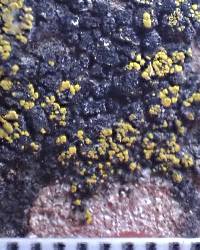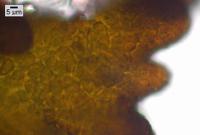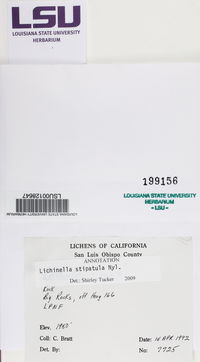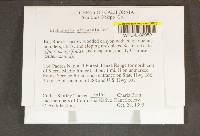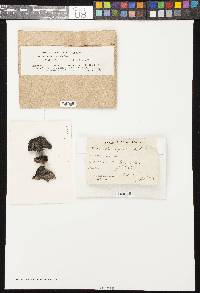
Consortium of Lichen Herbaria
- building a Global Consortium of Bryophytes and Lichens as keystones of cryptobiotic communities -
- Home
- Search
- Images
- Species Checklists
- US States: O-Z >
- US National Parks
- Central America
- South America
- US National Parks
- Southern Subpolar Region
|
|
|
|
Family: Lichinaceae
[Lichina stipatula (Nyl.) Boistel] |
Nash, T.H., Ryan, B.D., Gries, C., Bungartz, F., (eds.) 2007. Lichen Flora of the Greater Sonoran Desert Region. Vol 3. Thallus: small, superficially appearing crustose, but forming compact, fruticose cushions 2-8 mm wide and 2-4(-5) mm tall branches: irregularly cylindrical, irregularly branched, 0.5-3 mm long, (25-)50-100 µm thick, centrally with a distinct fountain-like hyphal strand of 1-2 rows upper surface: black, dull to slightly glossy, without isidia, but the branches themselves may appear isidioid lower surface: concolorous with the upper surface, attached by tufts of rhizohyphae Apothecia: thallinocarpous, terminal on tips of branches, 0.2-0.3 mm wide, ±round or irregular, flat to convex or rarely concave with raised margin disc: rough, plane or uneven, concolorous; margin: thalline, up to 50 µm wide, usually indistinct; proper exciple: lacking hymenium: hyaline, IKI+ blue turning rapidly reddish brown or wine red, continuous but groups of photobiont cells intrude between the asci, 200-300 µm wide, c. 90 µm tall, covered by ±continuous layer of sterile thalline tissue interrupted only by elongating asci; subhymenium: hyaline, continuous, 20-25 µm thick, IKI+ blue ascus: 16-24(-32)-spored ascospores: hyaline, simple, ellipsoid, small, (5-)7-9(-10) x 3-4.5 µm Pycnidia: terminal, globose conidia: fusiform, c. 3 x c. 1 µm Spot tests: all negative Secondary products: none detected. Substrate and ecology: on siliceous rock World distribution: North America, Europe, NW Africa, Macaronesia, Middle East, and Socotra Sonoran distribution: Arizona, California, Baja California, and Baja California Sur. Notes: Lichinella stipatula is the most common of the dwarf-fruticose species in the genus. It occupies rather different habitats such as desert soil crust, sand-filled clefts in calcareous or siliceous boulders as wells as bare rock surfaces along seepage tracks. The minute, black cushions are very inconspicuous and often hard to recognize among more colorful lichens. Lichinella stipatula is rather easily separated from other fruticose Lichinella species by its minute growth and the frequent presence of thallinocarps which are rarely formed in L. americana, and absent or very rarly found in L. flexa and L. robustoides. Spilonema revertens is very similar in the formation of cushions composed of confluent branches but clearly differs in the presence of a bluish black hypothallus and the Stigonema photobiont. Peccania subnigra differs in the presence of common apothecia, 8-spored asci, and filiform conidia. |
|
|
|
Powered by Symbiota




